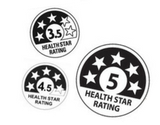The Health Star Rating

At Healthy Kids Association we believe making healthy choices should be easy. Health Star Ratings can help you make healthier choices, but they are just one tool to assist you to achieve a healthier diet and should be considered alongside other information such as the Australian Dietary Guidelines. Starting with keeping an eye out for five stars when you’re at the supermarket will go a long way to improving healthy choices for the whole family.
We also advocate educating yourself on nutrition labels and panels on food and drink, but this isn’t easy and takes time. The eatforhealth.gov.au website has a handy cheat sheet if you’re interested in trying this tactic at the supermarket. As a first step, the Health Star Rating Scheme is designed to identify a healthier choice among similar products quickly and easily by placing a star rating printed on the front of food packaging.
Here’s what you need to know to fully understand the scheme.
How it works
A food can be rated anywhere from ½ a star to 5 stars, with five stars indicating it’s a healthy option. Overall, the system encourages the consumption of whole core foods from the five food groups. It highlights that all foods have a place in the diet while showing that some are better for you than others.
The Health Star Rating Calculator uses a calculation based on measuring aspects of the food that are associated with an increased risk of chronic diseases such as the energy (kilojoules), saturated fat, sodium and sugars. It also looks at ‘positive’ aspects of the food such as fibre, protein and the percentage of fruit, vegetables, nuts and legumes in the food (where applicable). A star rating is then calculated for the food.
The star system is easy to understand: put simply, the more stars the healthier the food. However, there are a few important considerations you should watch out for:
- The health star rating is calculated using a 100 gram serving size of each food. This means it’s important to look at the serving size when choosing a food product.
- The star rating works only when used with like-for-like products, such as comparing muesli bars with other muesli bars, NOT muesli bars with yoghurt.
- Food manufacturers are able to add extra fibre (in the form of inulin) and protein (in the form of whey or skim milk powder) to a product so that the number of stars the product receives is increased. These added nutrients may not be as healthy as the nutrients that exist naturally in a food, yet the star rating doesn’t differentiate.
- Choosing a variety of foods from the five food groups should be encouraged, regardless of the star rating. For instance, a dairy product may not receive five stars, but it’s an important food group that’s vital to a child’s healthy growth and development. Dairy supplies a rich source of calcium to the diet, which is essential for strong bone and teeth development.
- If a product receives 4 or 5 stars, it doesn’t mean you can eat as much as you like. Consumers still need to watch their portion sizes.
Overall, the Health Star Rating Scheme is a step in the right direction for consumers who are trying to make a healthier choice. However, in order for it to be as an effective as possible, educate yourself on appropriate serve sizes and stick to fresh unprocessed items from the five food groups.







